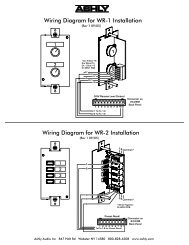ASHLY ne24.24M / 24.24M : RS-232 control protocol
ASHLY ne24.24M / 24.24M : RS-232 control protocol
ASHLY ne24.24M / 24.24M : RS-232 control protocol
You also want an ePaper? Increase the reach of your titles
YUMPU automatically turns print PDFs into web optimized ePapers that Google loves.
4 $2A Header byte 3<br />
5 06 Header byte 4<br />
6 id <strong>24.24M</strong> Device ID index, defined as (Device ID – 1); Default value = 0; (See Note #3 on page 1)<br />
7 $0D Message type 13 ($0D) = Delay Message<br />
8 xx Channel: 0-19 = Inputs 1-20, 64-83 = Outputs 1-20<br />
9 yy Delay bits 20-14; Delay time in seconds = (21-bit Delay Word)/(48,000)<br />
10 yy Delay bits 13-7; Delay word range = 0-32,760 (0-682.500 ms)<br />
11 yy Delay bits 6-0;<br />
12 $F7 Stop byte<br />
Note: there is an additional propagation delay of 1.46 ms from any input to any output, due to the digital converters & DSP.<br />
14 - EQ Filter Message<br />
Byte# Value Description<br />
1 $F0 Start byte ($ denotes hexadecimal numbers, see Note #1 on page 1)<br />
2 00 Header byte 1<br />
3 01 Header byte 2<br />
4 $2A Header byte 3<br />
5 06 Header byte 4<br />
6 id <strong>24.24M</strong> Device ID index, defined as (Device ID – 1); Default value = 0; (See Note #3 on page 1)<br />
7 $0E Message type 14 ($0E) = EQ Filter Message<br />
8 xx Channel: 0-19 = Inputs 1-20, 64-83 = Outputs 1-20<br />
9 yy Filter number: 0 = filter 1, 1 = filter 2, etc…<br />
10 ff Frequency bit 14 (xxxxxxxE) 15-bit Frequency Word = actual frequency in Hertz<br />
11 ff Frequency bits 13-7 (xDCBA987) [see limits below]<br />
12 ff Frequency bits 6-0 (x6543210) [also, see Sample Frequency Bytes at the end of this doc]<br />
13 qq Q-index range: 11-107 = 1/64 to 4 oct [see Bandwidth vs. Q-index Bytes at the end of this doc]<br />
14 gg Filter Gain bits 13-7 (xDCBA987) [see limits below]<br />
15 gg Filter Gain bits 6-0 (x6543210) [also, see Sample Gain Bytes at the end of this document]<br />
16 st Status & Type: bit 6 (status) - 0 = bypass, 1 = active;<br />
lower nibble (type) - Value 0-5 = PEQ, LS1, LS2, HS1, HS2, Allpass<br />
17 $F7 Stop byte<br />
EQ Notes:<br />
Parametric filter frequency range: 20 Hz to 20,000 Hz<br />
Parametric filter gain range: -30dB to +15dB in 0.1dB steps; 14-bit Gain Word = 7892 to 8342 (8192 = 0dB)<br />
Low Shelf frequency range: 20 Hz to 2,000 Hz<br />
High Shelf frequency range: 3,890 Hz to 20,000 Hz<br />
Shelf filter gain range: -15dB to +15dB in 0.1dB steps; 14-bit Gain Word = 8042 to 8342 (8192 = 0dB)<br />
15 - Gate Message<br />
Byte# Value Description<br />
1 $F0 Start byte ($ denotes hexadecimal numbers, see Note #1 on page 1)<br />
2 00 Header byte 1<br />
3 01 Header byte 2<br />
4 $2A Header byte 3<br />
5 06 Header byte 4<br />
6 id <strong>24.24M</strong> Device ID index, defined as (Device ID – 1); Default value = 0; (See Note #3 on page 1)<br />
7 $0F Message type 15 ($0F) = Gate Message<br />
8 xx Channel: 0-19 = Inputs 1-20<br />
9 tt Threshold: 20-120 = -80 to +20 dBu<br />
10 ff Floor: 0-19 = Off (-INF); 20-100 = -80 to 0 dBu<br />
11 ar Attack rate: 0-7 = 0.2, 0.5, 1, 2, 5, 10, 20, 50 ms/dB<br />
12 rr Release rate: 0-7 = 5, 10, 20, 50, 100, 200, 500, 1000 ms/dB<br />
13 ss Status: 0 = bypass; $1-7F = active<br />
14 $F7 Stop byte





